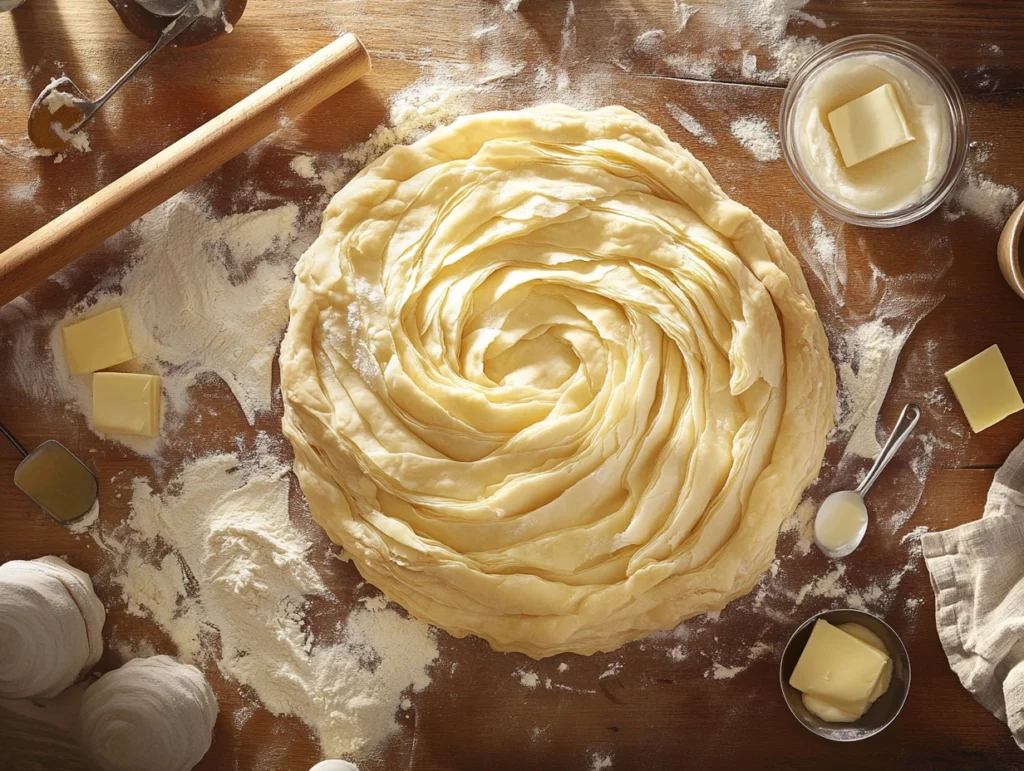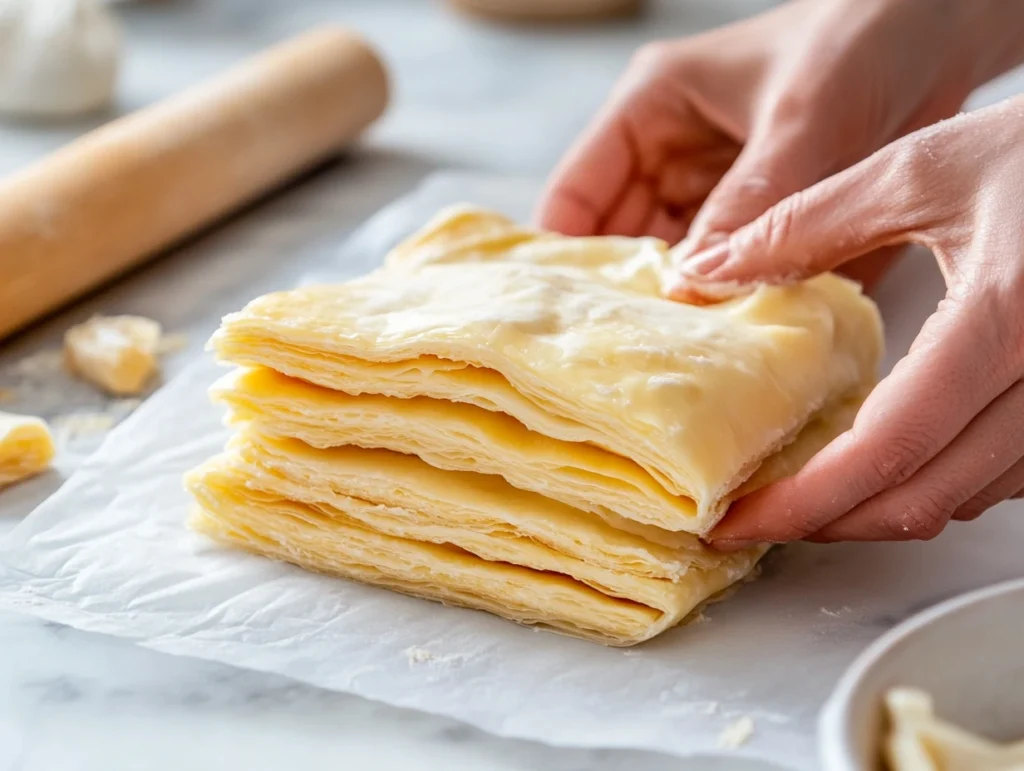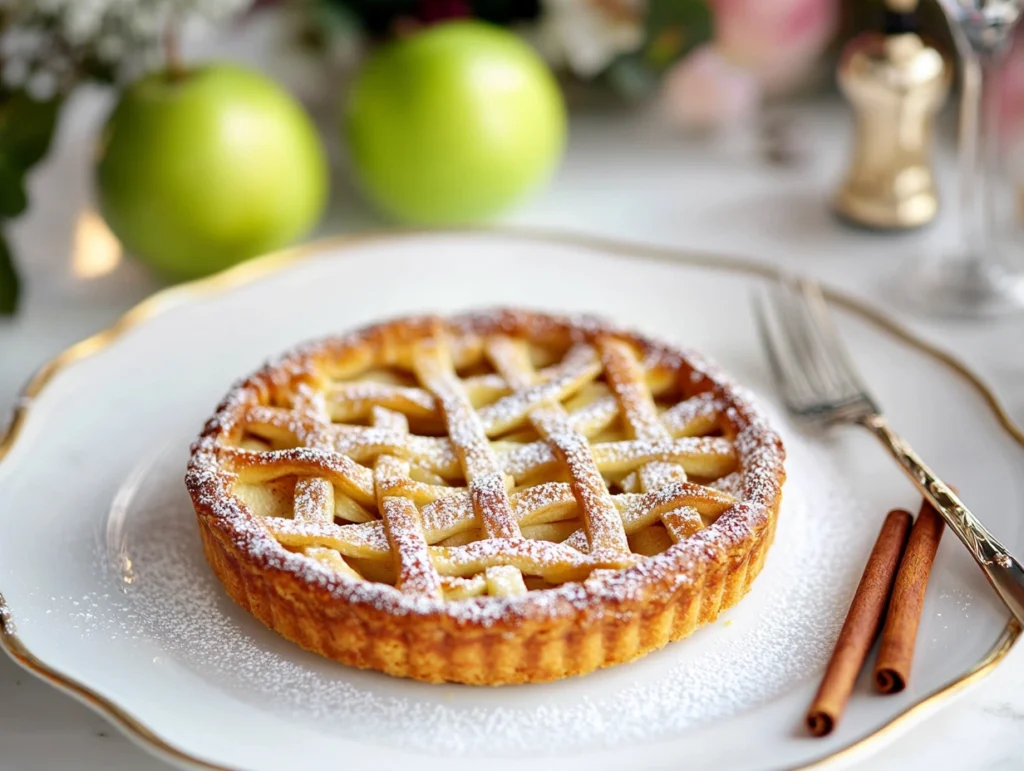What Are the 4 Types of Pastry? Pastry is a versatile culinary delight, celebrated across cultures and cuisines. From buttery, flaky layers to crisp, paper-thin sheets, pastries offer an array of textures and flavors that appeal to every palate. In this article, we’ll dive deep into the world of pastries, unraveling the secrets behind the four main types of pastry: shortcrust, puff, filo, and choux. Whether you’re a seasoned baker or a beginner exploring the art of pastry, this guide will equip you with the knowledge to create mouthwatering baked goods.
Overview of Pastry Types
Introduction to Pastry
Pastry is much more than just dough. It’s a delicate blend of flour, fat, and sometimes water that, when skillfully handled, transforms into culinary masterpieces. From savory pies to sweet tarts, pastry is the cornerstone of countless recipes. Its unique texture and structure set it apart from regular dough, giving pastries their iconic flaky or crumbly consistency.
Pastries have been a staple in kitchens worldwide for centuries. They’re not just limited to desserts but are equally cherished in savory dishes. Whether you’re savoring a buttery croissant or biting into a crisp samosa, you’re experiencing the marvel of pastry.
Distinction Between Dough and Pastry
Though often used interchangeably, dough and pastry aren’t the same. Dough is a broader category, encompassing everything from bread to pizza bases. Pastry, on the other hand, is all about precision and finesse.
One crucial distinction lies in the treatment of fat. In pastry, fat plays a central role in creating layers or a crumbly texture, depending on the type. Laminated pastries, such as puff pastry, involve folding fat into the dough to create distinct layers. Non-laminated pastries, like shortcrust, are mixed directly for a uniform texture.
Understanding these basics sets the stage for mastering the four main types of pastry, which we’ll explore in detail in the next section. Get ready to elevate your baking game!
The Four Types of Pastry

Shortcrust Pastry
Shortcrust pastry is one of the most common types and serves as the foundation for many delicious recipes. This pastry is all about simplicity and precision. Made with flour, butter, and water, it creates a crumbly, melt-in-your-mouth texture.
- What Is Shortcrust Pastry?
Shortcrust is a non-laminated dough, meaning it lacks the distinct layers found in puff pastry. The fat is cut into the flour to coat the particles, ensuring a tender texture. It’s easy to handle, making it a favorite for beginner bakers. - Uses of Shortcrust Pastry
Popular recipes include savory pies, sweet tarts, and quiches. Its structure holds fillings well, whether you’re making a hearty meat pie or a fruit tart. - Advantages of Shortcrust Pastry
This pastry is versatile and forgiving, ideal for quick recipes. You can experiment with different fats, such as butter for richness or shortening for extra flakiness.
Puff Pastry
Puff pastry is a showstopper, prized for its dramatic, flaky layers that puff up beautifully during baking. This pastry is all about patience and technique.
- What Is Puff Pastry?
Puff pastry is a laminated dough, where layers of butter are folded into the dough multiple times. During baking, the water in the butter turns to steam, creating the distinct airy layers. - Culinary Applications of Puff Pastry
It’s perfect for croissants, vol-au-vent, and mille-feuille. You can also use it for savory dishes like sausage rolls or puff pastry pizza. - Tips for Working with Puff Pastry
Keeping the dough cold is key to success. Always chill between folds to prevent the butter from melting. If you’re new to puff pastry, try ready-made sheets for a quick start.
For step-by-step techniques for puff pastry, you can explore guides like Puff Pastry Breakfast Recipes.
Filo Pastry
Filo pastry, known for its thin and delicate sheets, requires a steady hand and a lot of patience. It’s most popular in Mediterranean and Middle Eastern cuisine.
- Understanding Filo Pastry
Unlike other pastries, filo is made with unleavened dough stretched until paper-thin. Layers are brushed with butter or oil for a crisp, golden finish. - Dishes Made with Filo Pastry
Think baklava, spanakopita, or samosas. Its crisp texture pairs well with both sweet and savory fillings. - Challenges in Using Filo Pastry
Filo dries out quickly, so work fast and cover unused sheets with a damp cloth. Its delicate nature makes it tricky, but the results are worth the effort.
Choux Pastry
Choux pastry stands out for its unique method of preparation and its role in creating some of the most iconic pastries.
- Basics of Choux Pastry
Made by cooking flour, water, butter, and eggs on the stove, choux dough is piped into shapes before baking. Its high moisture content allows it to puff up, creating hollow centers. - Iconic Recipes Using Choux Pastry
Éclairs, profiteroles, cream puffs, and croquembouches all start with choux. The hollow centers are perfect for filling with cream, custard, or savory mixtures. - Mastering the Art of Choux Pastry
Precision is essential. Avoid opening the oven during baking, as sudden temperature changes can deflate the pastries.
Explore more about similar techniques through recipes like French Breakfast Puffs.
Choosing the Right Pastry for Your Recipe
Key Factors in Selection
Choosing the right pastry depends on the dish you’re making. Need a stable base for a hearty quiche? Shortcrust pastry is your go-to. Want something airy and dramatic for a dessert? Puff pastry might be better.
Common Substitutes and Alternatives
In some cases, pastries can be swapped. For instance, puff pastry can replace filo for a crisp, flaky crust. However, texture and preparation time may vary. For a quick dessert, ready-made dough can be a lifesaver.
Expert Tips for Perfect Pastries
- Always measure ingredients accurately.
- Keep butter and dough cold when working with laminated pastries.
- Practice folding techniques for puff and choux doughs to improve over time.
Each type of pastry has its unique traits, but with practice and attention to detail, anyone can master these culinary essentials.
FAQs About Pastries
What Is the Difference Between Pastry and Cake?
Many people confuse pastry with cake, but they’re quite different. Pastries are made with a higher fat-to-flour ratio, resulting in flaky or crisp textures, while cakes are typically soft, spongy, and rely on leavening agents like baking powder. Pastries also encompass a wide variety, including savory options like pies and quiches, whereas cakes are almost always sweet.
Can You Freeze Pastry Dough?
Absolutely! Freezing pastry dough is a great way to save time. Both shortcrust and puff pastry freeze exceptionally well. Wrap the dough tightly in plastic wrap and store it in an airtight container. When you’re ready to bake, simply thaw it in the fridge overnight. Avoid freezing filo or choux dough, as their delicate textures don’t hold up well in the freezer.
How to Fix Common Pastry Problems?
- Dough is too crumbly: Add a little cold water, one tablespoon at a time, until the dough holds together.
- Pastry shrinks while baking: Rest the dough in the fridge for at least 30 minutes before baking.
- Soggy bottoms: Pre-bake the crust (blind bake) before adding the filling.
For more detailed tips and tricks for avoiding common pastry mishaps, consider exploring tutorials or step-by-step guides like French Breakfast Puffs.
Conclusion and Final Thoughts
Recap of the Four Types of Pastry
So, what are the 4 types of pastry? To recap, they include:
- Shortcrust pastry, perfect for pies and tarts.
- Puff pastry, famous for its light, flaky layers.
- Filo pastry, known for its thin, crispy sheets.
- Choux pastry, the foundation for cream puffs and éclairs.
Each type has unique qualities that cater to different culinary needs, from sweet desserts to savory snacks.
Encouragement to Explore Pastries in Baking
Pastries may seem intimidating, but with practice, anyone can master them. Start simple with shortcrust pastry, then challenge yourself with puff or choux. Baking is as much about creativity as it is about precision, so don’t be afraid to experiment.
For more delicious recipes and baking ideas, check out our extensive recipe collection. Whether you’re a beginner or a pro, there’s always something new to learn and enjoy.
Tips for Mastering Pastry Dough
Understanding the Basics

To master pastry dough, start with the fundamentals. Each of the four types—shortcrust, puff, filo, and choux—requires unique techniques and attention to detail. Always use fresh, high-quality ingredients like unsalted butter and unbleached flour, as they significantly impact the flavor and texture.
Essential Tools for Perfect Pastries
Having the right tools makes a big difference. A rolling pin is essential for puff and filo pastry, while a food processor can speed up the process for shortcrust. For choux pastry, a piping bag with various tips helps you shape éclairs or cream puffs with precision.
Troubleshooting Pastry Challenges
Even experienced bakers face challenges with pastries. If your puff pastry isn’t rising, the butter may have melted before baking. For shortcrust pastry that cracks, avoid overworking the dough, as this can make it too stiff.
Experimentation Is Key
Don’t hesitate to experiment with flavors and fillings. Add herbs and spices to shortcrust for savory pies or cinnamon and nutmeg to choux for a sweet twist.
Remember, practice makes perfect. The more you work with these doughs, the more confident you’ll become in creating everything from croissants to baklava. If you’re looking for inspiration, explore resources like Puff Pastry Breakfast Recipes.
Frequently Overlooked Pastry Tips
Keep Ingredients Cold
Cold ingredients are the secret to flaky, tender pastries. Whether making shortcrust pastry or laminating dough for puff pastry, cold butter creates those desired layers. Keep your tools, like mixing bowls and rolling pins, in the fridge for extra control.
Resting the Dough
Always let your dough rest before rolling or baking. Resting allows the gluten to relax, preventing shrinkage and ensuring an even bake. For choux pastry, resting the piped shapes before baking ensures better puff and texture.
Preheating the Oven
Proper oven temperature is critical, especially for pastries like choux and puff. A fully preheated oven ensures the dough rises and bakes evenly. An oven thermometer is a small investment but ensures accuracy.
Don’t Skip Egg Wash
For that golden, glossy finish, an egg wash is indispensable. It’s particularly useful for puff pastry and turnovers, adding a professional look to your baked goods.
By following these often-overlooked tips, you can elevate your pastry-making skills and confidently create dishes that rival those from professional bakeries. And remember, the answer to what are the 4 types of pastry lies not just in knowing their names but in understanding how to perfect each one.
Popular Pastry Recipes to Try
Classic Recipes for Beginners

If you’re just starting out with pastry, begin with simple recipes that showcase each type. For shortcrust pastry, try a classic apple pie or a savory quiche. These recipes are forgiving and perfect for honing your skills. For puff pastry, an easy option is cheese straws or pre-made sheets for turnovers.
Advanced Recipes for the Adventurous
Once you’re comfortable, challenge yourself with more complex recipes. Puff pastry shines in croissants, while choux pastry is the base for elegant éclairs or cream puffs. If you’re feeling creative, try crafting baklava with filo pastry, layering nuts and honey for a rich, flaky treat.
Seasonal and Themed Pastries
Pastry is incredibly versatile and adapts well to seasonal flavors. Pumpkin hand pies with shortcrust pastry are perfect for fall, while berry galettes are a hit in summer. During the holidays, puff pastry stars in appetizers like brie and cranberry bites.
Each of these recipes offers a chance to refine your techniques while exploring new flavors. So, when someone asks, what are the 4 types of pastry and what can you make with them, you’ll have plenty of delicious answers.
Where to Learn More About Pastries
Online Tutorials and Resources
Thanks to the internet, there’s no shortage of resources to help you master pastry-making. YouTube channels and cooking blogs offer step-by-step guides, often focusing on one pastry type at a time. Websites like Elon Recipes feature a range of recipes and tips, including dishes like French Breakfast Puffs or Puff Pastry Breakfast Recipes.
Books for Aspiring Bakers
For those who love physical resources, cookbooks focused on pastries can be invaluable. Look for ones that provide detailed techniques and troubleshooting tips. Some recommended titles include The Art of French Pastry by Jacquy Pfeiffer and Pastry School by Le Cordon Bleu.
Hands-On Baking Classes
If you prefer a more interactive experience, consider enrolling in a local or virtual baking class. These classes often provide personalized guidance, making it easier to tackle tricky pastries like puff and choux.
Learning about pastries is a lifelong journey. With the variety of resources available, you’ll always find new techniques to master and recipes to try. Whether you’re exploring online guides or classic cookbooks, your pastry skills are bound to flourish.
